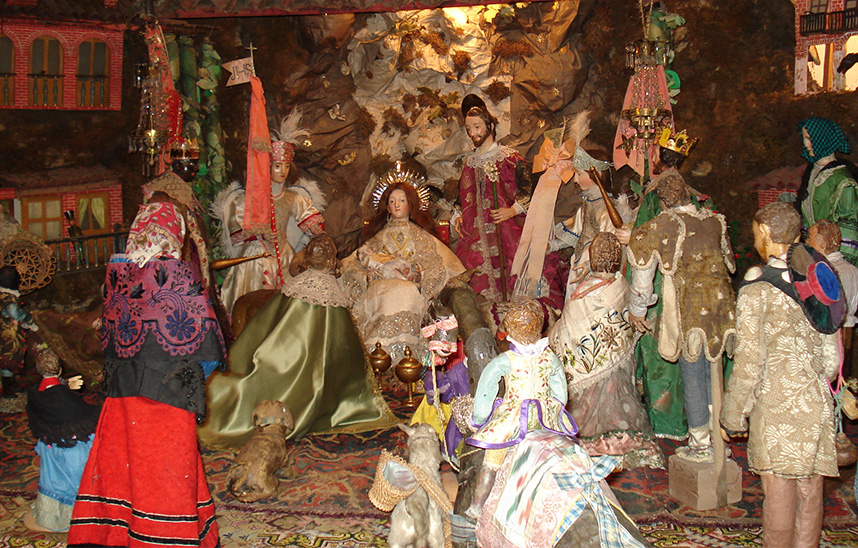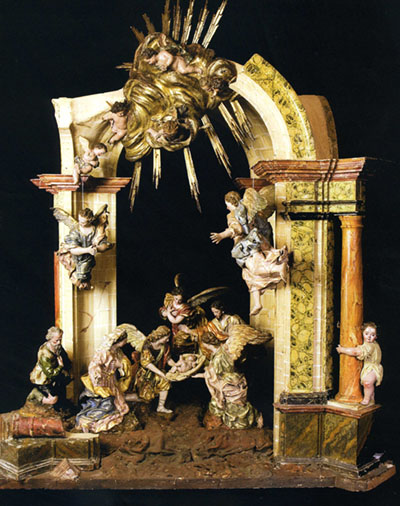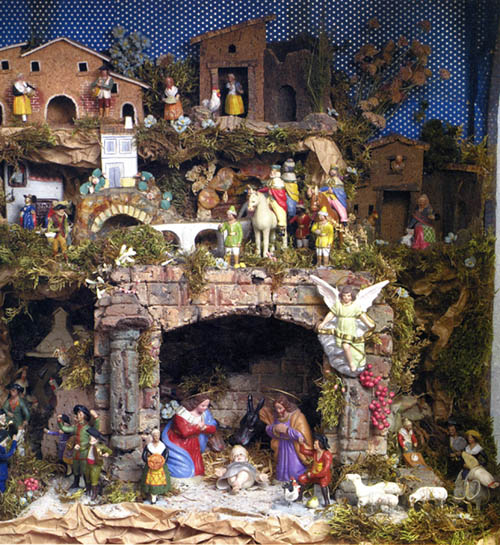Reflections on development of the Nativity Scene in Spain

Photo /Monumental Bethlehem of the Augustinian Recollect Nuns of Pamplona. XVII and XVIII centuries
The history of the nativity scene in Spain is gradually taking shape. Along with the works on the eighteenth-century royal nativity scenes and that of Francisco Salzillo, we have others to confront and contextualize their study, among which we can highlight those of Leticia Arbeteta, Cristóbal Belda, Antonio Basanta, Rafael García Serrano or Isabel Gómez de Rueda. Many of their texts propose the topic and propose a serious and rigorous methodology for its research.
The origins of the nativity scene must be related, more than with the laconic news of the Gospel story, with the apocrypha and, above all, with the Christmas theater that had a wide development since the times of the Age average, in spite of the prohibitions of Innocent III. A singular milestone in the history of the Nativity Scene was the staging that St. Francis of Assisi devised on Christmas Eve 1223, with papal permission, in Greccio. The Franciscans, in their masculine and feminine branches, became the apostles of this singular custom, combining naturalistic and symbolic aspects in the stagings.

Bethlehem of the Conceptionists of Miedes, late XVII century.
A nativity scene is not only Christmas iconography. It is not, therefore, paintings, sculptures or engravings of the cycle of Christ's infancy. It is a three-dimensional and scenographic representation of the birth of Christ, made with mobile figures, on a fixed stage that is set up for the Christmas season. They are generally ephemeral and seasonal constructions, a small, reduced and static universe that houses people, animals and houses. The sources for their study in Spain are scarce, since it is very difficult to know how the assemblies were made before the end of the 19th century. In addition, documentary references are very scarce. The notarial inventories of the houses of our ancestors, so detailed in so many aspects, hardly record the existence of figures of the nativity scene. In most of the peninsular regions, it is in the religious enclosures, where we find the most significant examples, as much in those of monumental size, as in the reductions of those, inside the denominated showcases, that are some urns or showcases with the front of glass, in whose interior appear figurines of clay or wax richly dressed.
The centuries of the Baroque
The centuries of the Baroque meant a definitive impulse for the development of the nativity scenes, and not by chance, since at that time the space, the scenographies and the popular elements were valued more than ever, at the same time that there was a coincidence with certain values of piety and religiosity tending to captivate the faithful through the senses, with the conviction that Jesus awakens, during Christmas, in the heart of the devout souls. In this context, we cannot be surprised that it was in eighteenth-century Naples where the nativity scene genre acquired a special relevance, although it is not sustainable that from those lands such a custom arrived in Spain since, in the peninsula there are enough testimonies previous to the Neapolitan hatching. To the XVII century in Spain belong numerous examples in temples and monasteries and even in private houses, standing out the works of Luisa Roldán, La Roldana, sculptress of the king and the wax figurines of the mercedarian fray Eugenio Gutiérrez de Torices, qualified by the Italian painters Mitelli and Colonna as "miracolo della natura". In this regard, we cannot fail to remember that Lope de Vega himself installed a nativity scene in his house, copying it from the altarpiece of a church, with removable figures, at Christmas time.

Portal of the crib of Francisco Salzillo. 1776-1783. Salzillo Museum of Murcia
However, it was in the 18th century when excellent examples were produced in Germany and throughout the Mediterranean and even Latin America. Masters such as the Andalusian Pedro Duque Cornejo carved expressive and carefully polychrome figures. In that century, the famous Neapolitan sets of terracotta and wood figures arrived at the Court and were destined for noble houses, in which the arrival of the Christ Child into the world came to be considered as a natural event, in a world full of men who carried out their activities and who, at a certain moment, heard the news, celebrating it as something that was their own in an authentic festive microcosm, with great spontaneity and vitality and with articulated mannequin figures, which allowed mobility.
A true milestone in the development of the Hispanic nativity scene was the set commissioned, in 1776, to the sculptor Francisco Salzillo by Don Jesualdo de Riquelme, a wealthy Murcian hero who, after a trip to Madrid, became enthusiastic about the art of nativity scenes. The famous artist recreated the story of the coming of Christ into the world, in a popular environment taken from the pastoral environment, with popular types of the Murcian orchard, and inspired by the engravings of popular costumes, the work of the famous engraver Juan de la Cruz. Other sculptors such as the Andalusian Pedro Duque Cornejo made expressive figures and of careful polychromies. Some masters of the second half of the eighteenth century, would not remain oblivious to the Neapolitan influence, making richly dressed mannequins. The Valencian Jose Esteve, came to make up to one hundred and eighty figures of 50 cms. of height for the nativity scene of Prince Charles, son of Charles III. The high issue of orders should not surprise us, since the palace nativity scenes came to have almost six thousand figures, many of which were dispersed, later, between museums and other private collections.
The popularisation of nativity scenes since the time of Charles III
Some noble families, eager to emulate the fashions imposed by Charles III in the Madrid Court, did the same in their mansions. In this respect, it is necessary to remember the text of José Blanco White, collected in his "Letters from Spain" (1808), whose content is applicable to many Hispanic cities. Thus reads its content: "Thirty or forty years ago, the wealthy families had the custom of preparing, for a public exhibition, two or three rooms of the house, in which on a rustic imitation of rocks and mountains, they placed between lamps and candles a large number of clay figures representing the most common actions of life. In the center of the scene one could see a stable half in ruins with the figures of Joseph, Mary and several shepherds, kneeling in attitude of adoring the Child reclining in the manger, action that a donkey and an ox imitated with the greatest composure. This collection of dolls called nativity is still exhibited in many houses, although no longer for the public, but for the amusement and pious satisfaction of the family and the most intimate friends. At this time to which I refer, nativity scenes were a pretext for organizing large parties and spending several evenings dancing and entertaining... The rooms were lighted up at dusk, and not only the friends of the family were entitled to enjoy the party, but also any gentleman who gave his name at the door, could introduce one or more ladies, whom, although the owner of the house knew only by sight, were begged to take part in the amusements in progress. These consisted of singing, dancing and, frequently, reciting lines from comedies of the old Spanish theater, known by the name of relaciones. Reciting was, until recently, considered a good hobby in both men and women, and those who had this skill would rise at the request of those assembled to declaim, acting in the style of our old school of oratory, just as others amused the concurrence by playing some instrument. A light refreshment of Christmas cakes, called hojaldres, and sweet wine or homemade liquors, was enough to free the house from the accusation of stinginess. In this way, entertainment and society were achieved with a very moderate expense . But the nativity scenes of to-day seldom offer amusement to strangers, and with the exception of carol singing to the sound of the zambomba, little is left of the old festivities."

Nativity scene of the parish of Mendigorría by Juan José Velaz. 1825. Diocesan Museum of Pamplona
Much of what is stated in this interesting document, has been repeated in many cities and towns throughout the nineteenth century and early decades of the last century. Bourgeois, farmers with possible and families with wealthy economic position, acquired their particular assemblies and figures. Their homes were witnesses of all those celebrations around the nativity scene, and even organized rounds by gangs and auroros to visit such singular assemblies.
The 19th century: the nativity scene in the home
The custom of setting up a nativity scene spread to homes well into the 19th century, in the midst of the Romantic period, with notable works, such as those of the Catalan artist Ramón Amadeu, but above all with small clay figures of great ingenuity. The nativity scenes became small festive oratories around which families gathered, with tambourine or zambomba in their hands, the carol in their voices, the movement of the dance in their feet and the joy in their hearts. The nativity scenes of large proportions and quality figures, called "de fino" were the heritage of the wealthier classes and religious institutions and were purchased to order, while the "de vasto" could be purchased at markets and stores, which imported them from the lands of Levante or Granada.
The popularity achieved by the Murcian and Granadian artists flooded the market since the mid-nineteenth century, before the Catalan workshops of the Olot school captivated with their particular historicist vision, derived from the group of the Nazarenes, German painters who reacted against the prevailing Neoclassicism based on the archaeological discoveries in Palestine. In the same vein, the artists of the Parisian street of Saint Sulpice had a decisive influence in Catalonia on the Olot school with a correct style, somewhat sweet and influenced by the Nazarene aesthetics. With these assumptions, many institutions and individuals opted for those figures, standardizing everything related to the nativity scene, always from the orientalist perspective. For the time being, the figures from the Olot workshops coexisted with the traditional terracotta ones, but the latter would eventually prevail.

Nativity scene with Murcian figures from the XIX century. Private collection
Regarding the anthropological values of our old nativity scenes, we will quote the testimony of Julio Caro Baroja. In his book of family memories, he confesses his fondness, since childhood, for acquiring figures. There he tells us how, in the Madrid of a century ago, it was still possible to acquire models from nineteenth-century molds from Granada and Murcia. Among the paragraphs of the cited work, we read: "All the old peasant society of the South could be found represented in figures and groups, independently of the physical training or of agreement to a canon of the Christmas Nativity ..... Nor was I interested in them because I thought they were humble or poor in spirit, but because it amused me to think of their daily work, in their yokes, wells, fountains with pitchers and little donkey with bucklers or watering troughs, in the equipment for spinning or other tasks".
